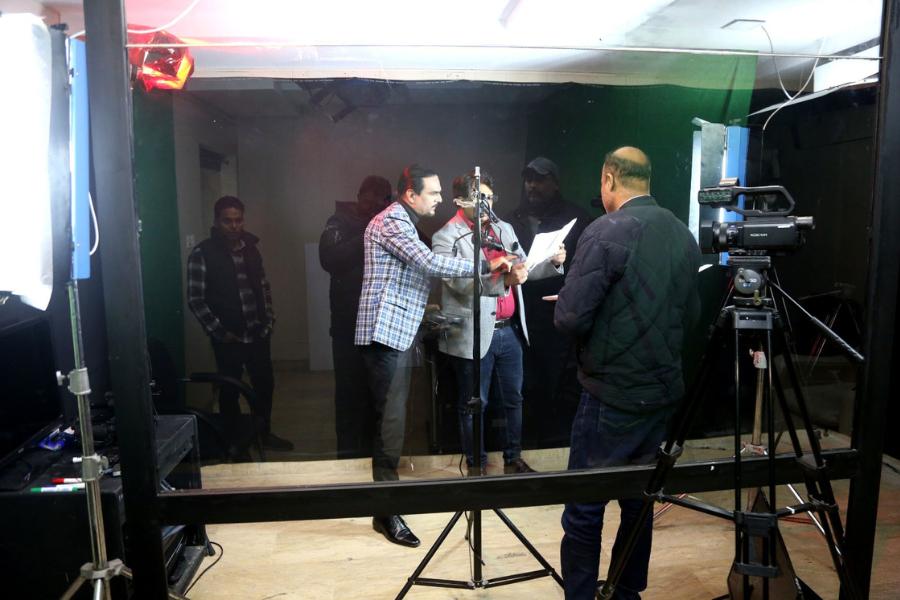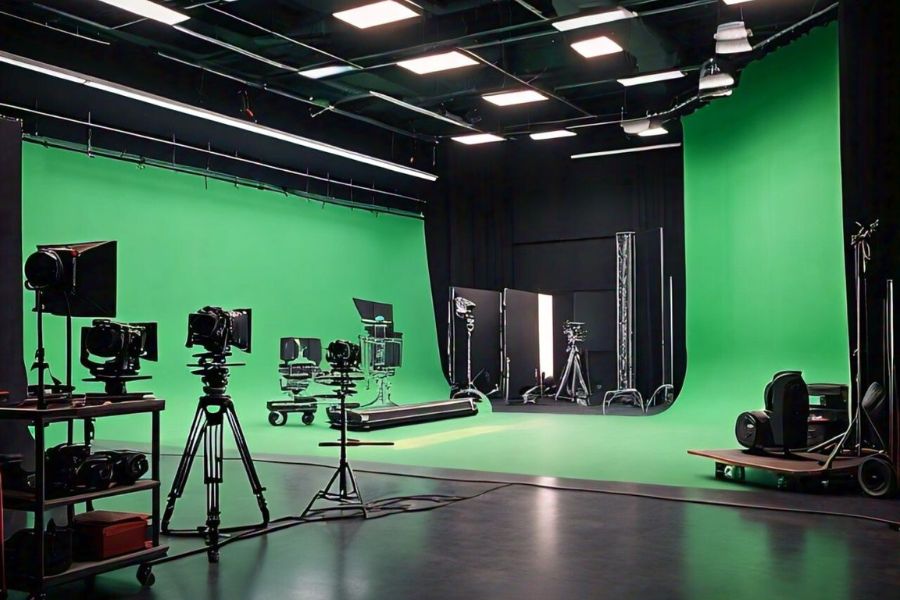Table of Contents of Film Studio Equipment
Introduction to Film Studio Equipment
Creating a successful film requires not just creative vision but also the right film studio equipment. Whether you’re a budding filmmaker or an experienced professional, having essential equipment can make or break your production quality. This article explores ten must-have equipment pieces for every stage of film production, from pre-production to post-production and general use on set.
Pre-Production Equipment
1. Camera

The camera is the heart of any film production. While DSLRs are popular for their versatility, dedicated cinema cameras offer superior image quality, dynamic range, and professional codecs that provide better editing flexibility.
Camera Choices for Filmmaking:
DSLRs (Digital Single Lens Reflex):
Pros: Versatile, often interchangeable lenses, good image quality, may already be owned by filmmakers.
Cons: Not specifically designed for video, may have limitations on video recording features or overheating during long shoots.
Cinema Cameras:
Pros: Superior image quality, wider dynamic range for capturing highlights and shadows, professional codecs for editing flexibility, built for long video recording times.
Cons: Generally more expensive than DSLRs, may require additional equipment like external monitors or recorders.
2. Tripod
A sturdy tripod is essential for stable shots and well-composed frames. Consider a fluid head tripod for smoother camera movements, especially for dynamic shots.
Types of Tripods:
Standard tripods: These are the most common type of tripod. They come in various heights and materials, such as aluminum or carbon fiber.
Travel tripods: These tripods are lightweight and compact, making them ideal for travel photography.
Fluid head tripods: These tripods have a special head that allows for smoother camera movements, panning and tilting. They are ideal for videography and creating dynamic shots.
3. Lighting Kit
Even basic lighting can elevate your production quality significantly. A three-point lighting setup consisting of a key light, fill light, and backlight offers versatility and enhances visual appeal.
Three-Point Lighting Kit
Key Light: This is the main light source in your scene. It casts the most prominent shadows and defines the overall look and feel. Key lights can be positioned from various angles depending on the desired effect.
Fill Light: The fill light softens the shadows created by the key light. It fills in darker areas of the subject for a more even illumination and reduces harsh contrasts.
Backlight: The backlight separates the subject from the background by adding a rim of light around the edges. This creates depth and makes the subject pop.
Production Film Studio Equipment
4. Audio Recorder
Clean audio is crucial for professional videos. Using a dedicated audio recorder ensures high-quality sound capture separate from the camera’s internal microphone, reducing background noise.
Zoom H4n Pro Handy Recorder: Portable recorder with X/Y stereo mics and external mic support. Product Link
Tascam DR-40X Portable Audio Recorder: Dual XLR inputs, adjustable built-in mics, durable design. Product Link
Sony PCM-D10 Portable Audio Recorder: High-res audio, stereo mic array, excellent noise reduction. Product Link
5. Microphone
A shotgun microphone mounted on the camera provides directional sound pickup, focusing on subjects within the frame while minimizing unwanted ambient noise.
RODE NTG4+ Shotgun Microphone: Directional mic for video paired with Zoom or Tascam recorder. Product Link
6. External Monitor
An external monitor is invaluable for monitoring focus, exposure, and overall image quality during filming. It allows directors and cinematographers to make real-time adjustments for better results.
Accurate Focus Monitoring: A larger screen allows for precise focusing, crucial for capturing sharp images.
Exposure Checking: With better detail, you can ensure proper exposure to avoid blown-out highlights or underexposed shadows.
Overall Image Quality: The increased screen size lets you evaluate colors, lighting, and composition more effectively.
Real-time Adjustments: Directors and cinematographers can make on-the-spot adjustments to lighting, framing, and other visual elements.
Post-Production Film Studio Equipment

7. Computer
A powerful computer equipped with video editing software like Adobe Premiere Pro or Final Cut Pro is essential for editing footage, adding effects, and creating a polished final product.
Desktop PCs:
High-End: Apple Mac Studio (M2 Ultra chip) or a custom-built PC with a high-end Intel Core i9 or AMD Ryzen 9 processor, Nvidia RTX 3080 or AMD Radeon RX 6800 XT graphics card, and 64GB of RAM. These are ideal for professional editors working with high-resolution footage (4K or 8K) and complex effects.
Mid-Range: Apple Mac Mini (M2 Pro chip) or a pre-built PC with an Intel Core i7 or AMD Ryzen 7 processor, Nvidia RTX 3060 Ti or AMD Radeon RX 6700 XT graphics card, and 32GB of RAM. This is a good option for enthusiasts or prosumers editing 1080p or 4K footage with moderate complexity.
Laptops:
High-End: Apple MacBook Pro (16-inch) with M3 Max chip or a gaming laptop with a powerful processor (like Intel Core i9 or AMD Ryzen 9) and a high-end graphics card (like Nvidia RTX 3080 or AMD Radeon RX 6800M). These are portable options for professional editors who need power on the go.
Mid-Range: Apple MacBook Pro (14-inch) with M2 Pro chip or a gaming laptop with a mid-range processor (like Intel Core i7 or AMD Ryzen 7) and a mid-range graphics card (like Nvidia RTX 3060 or AMD Radeon RX 6600M). This is suitable for creators who edit 1080p footage and need some portability.
8. External Hard Drive
Film projects generate large data volumes. Reliable external hard drives are necessary for storing footage, project files, and backups, ensuring data security and accessibility.
Examples of External Hard Drives:
WD My Book series: These popular drives come in various capacities (up to 8TB) and offer good performance and reliability. They often include backup software too.
Samsung T7 Touch SSD: This portable SSD offers super-fast transfer speeds, making it ideal for quickly moving large video files. It’s also quite rugged and compact.
G-Technology G-DRIVE series: Designed specifically for creative professionals, these drives are known for their durability and performance. They come in various capacities and configurations.
General Use Film Studio Equipment
9. Clamps and C-stands
These versatile tools help secure lights, microphones, flags, and other equipment on set, ensuring a safe and organized work environment.
10. Extra Batteries
Having spare batteries is crucial for uninterrupted filming. Ensure you have an ample supply to avoid delays during shoots.
Importance of Each Equipment
Each piece of equipment plays a vital role in ensuring a smooth and professional production process. Cameras capture visuals, tripods stabilize shots, lighting sets the mood, audio equipment ensures clear sound, and post-production tools bring everything together seamlessly.
Tips for Choosing Film Studio Equipment
Consider factors such as budget, intended use, technical specifications, and compatibility with existing gear when selecting equipment. Researching and testing equipment beforehand can help you make informed decisions.
Maintenance and Care

Regular maintenance and proper storage prolong equipment lifespan and maintain performance quality. Follow manufacturer guidelines for cleaning, storage, and usage to avoid unnecessary repairs or replacements.
Future Trends in Film Studio Equipment
As technology advances, expect innovations such as AI-driven editing tools, compact yet powerful cameras, and sustainable equipment options to shape the future of film production.
Conclusion
Equipping your film studio with essential tools enhances creativity, efficiency, and production quality. Invest wisely in equipment that aligns with your filmmaking goals, and prioritize maintenance to ensure longevity and consistent performance.
FAQs
1. Do I need expensive equipment to start filmmaking?
While quality equipment helps, beginners can start with entry-level gear and upgrade as needed based on experience and project requirements.
2. How important is lighting in film production?
Lighting plays a crucial role in setting the mood, highlighting subjects, and creating visual impact. Even basic lighting setups can significantly improve production quality.
3. What should I consider when buying a camera for filmmaking?
Factors such as sensor size, resolution, frame rates, lens compatibility, and ergonomics are essential considerations when choosing a camera for filmmaking.
4. Why is audio quality important in films?
Clear and immersive audio enhances storytelling, engages audiences, and contributes to overall production value. Investing in quality microphones and audio recording equipment is vital.
5. How do I ensure my equipment lasts longer?
Regular cleaning, proper storage, following usage guidelines, and timely maintenance checks can extend the lifespan of film studio equipment.

